 This year, under the title Europa 2021, PostEurop, a body of the Universal Postal Union, a specialized agency of the United Nations, has chosen a topical issue, in the context of the need to protect endangered European Fauna: Endangered National Wildlife.
This year, under the title Europa 2021, PostEurop, a body of the Universal Postal Union, a specialized agency of the United Nations, has chosen a topical issue, in the context of the need to protect endangered European Fauna: Endangered National Wildlife.
Romfilatelia introduces into circulation, on Thursday, April 22nd, 2021, a postage stamps issue with this name, consisting of two stamps. The stamps illustrate two endangered species of the Romanian Fauna: the European mink and the great bustard.
Also, on the postage stamps and labels, elements visible only in ultraviolet light are printed.
The first postage stamp of the issue, with the face value of Lei 3.40, illustrates the European mink (Mustela lutreola).
The mink lives near water, in swampy areas or near rivers, spending a lot of time in the water, looking for food. It is a medium-sized mammal (30-40 cm long), with a slim, elongated body and limbs with interdigital webbing, which helps it to swim. It is a predatory species; it feeds on fish, amphibians, crustaceans, small mammals.
Once widespread throughout Europe, the mink has today become one of the rarest and most endangered mammals on our continent. In some Western European countries, it has disappeared since the eighteenth century, and today it exists in only a few countries, including Romania. On the IUCN Red List (International Union for Conservation of Nature), the mink has the status of a critically endangered species – meaning it is only one step away from being declared extinct in the wild.
One of the causes is the destruction of the habitats of this species. Many vertebrate species have suffered from fragmentation and restriction of wetlands, to which water pollution has been added.
In Central and Western Europe, a major problem was the introduction of a foreign species, the American mink, which competed with the European mink for food resources and spread diseases that also infected European minks. A direct cause of the decline was hunting, the thick and fine fur of the mink being highly priced.
At present, several large-scale projects are aimed at restoring European mink populations. One of the areas where there is still a large population is the Danube Delta Biosphere Reserve (DDBR). Romania is carrying out an extensive conservation project, co-financed by the European Regional Development Fund: “Ensuring a favourable conservation status for rescuing from extinction the European mink population – Mustela lutreola (species of community interest, critically endangered) – from Romania”. The project is implemented by the Danube Delta Biosphere Reserve Administration in partnership with the Danube Delta National Research and Development Institute and includes: restoring natural areas in DDBR affected by construction, reorganizing tourism in DDBR, combating poaching, but also awareness-raising actions, in all schools in DDBR localities, on the importance of biodiversity conservation.
On the second postage stamp of the issue, with the face value of Lei 19.50, is represented the great bustard (Otis tarda).
The great bustard is the largest bird species in Europe in weight: adult males can weigh more than 15 kg. (Females are much smaller, weighing 4-5 kg.) Another characteristic of males are the so-called “whiskers”, in fact modified feathers, which grow at the base of the beak and reach their maximum length (about 20 cm) during the breeding season.
The great bustard is a plain bird; it lives in steppe meadows, but also on land cultivated with rapeseed, alfalfa, cereals. It feeds on vegetation, insects and small vertebrates. The range of this species extends from Western Europe (Spain and Portugal) to Central and Eastern Asia.
The great bustard was once widespread in the plains of Romania, but the spread of human civilization has profoundly affected this species: the vast desert meadows, where birds lived quietly, have been transformed into arable land, ploughed, irrigated, sprayed with pesticides, crossed by people and agricultural machinery; high voltage lines have appeared, which can lead to the death of many specimens, because the great bustards, despite their size, can fly at high speed. To these were added hunting and poaching, the great bustard being considered not only a tasty game, but also a trophy. The great bustard is a very vigilant bird and does not tolerate the presence of man at less than 250 m away, making it difficult to shoot, but people have found ingenious solutions to get closer to the right distance for shooting. The peasants hid, for example, behind silhouettes of cows, made of cardboard or wood. Another method was to hunt from the cart: the hunter was hiding under the mats, thus being able to approach the bustards, who were not afraid of carts and horses. Eventually, hunting and habitat destruction led, in our country, to such a drastic decrease in numbers, so that in the 1990s the great bustard was considered extinct in Romania.
In recent years, several specimens have been observed in the west of the country and in Baragan, which most likely belonged to the populations of the neighbouring countries. It was a surprise to discover, in 2020, a nest with great bustard eggs on an agricultural land in Salonta, Bihor County. Ornithologists from the Milvus Group Association, one of the most active NGOs in Romania in the field of bird and nature protection, hypothesized that the great bustards would have kept at Salonta “one last centre of resistance” and that there would be a small cross-border population of 40-50 specimens, occupying a territory located on either side of the border with Hungary.
So, the great bustard also lives in Romania, but it remains a vulnerable species and only through strict protection measures can we hope to see this magnificent bird populating the Romanian plains again.
A memorandum was drawn up under the Bonn Convention to conserve the Central-Eastern European great bustard population. Romania signed this agreement in November 2000.
A Natura 2000 protected area has been designated near Salonta, which bears the name of Cefa Fishery – Radvani Forest. Although insufficient in area, it offers at least the advantage that here, investment projects that would adversely affect great bustards can be blocked. Since 2017, a new package of agri-environmental measures has been implemented within the National Rural Development Programme, which provides compensatory payments for farmers who manage their lands by applying agricultural methods to protect the bustards.
Romfilatelia thanks “Grigore Antipa” National Museum of Natural History for the documentary support offered to the development of this postage stamps issue. 


